Online shopping has become a convenient and popular way to purchase goods, but it also comes with risks. The number of fake shopping websites is on the rise, putting consumers at risk of losing money or compromising their personal information.
Learning how to identify fake shopping websites is essential for a safe online shopping experience. This guide from FMCPAY will help you how to spot a fake website store, avoid scams, and know what steps to take if you’ve already fallen victim to a fake site.
1. What is a Fake Shopping Website?
Fake shopping websites are fraudulent online stores created to deceive customers. They are designed to mimic legitimate websites with similar logos, product listings, and even pricing, making them difficult to distinguish from authentic sites.
These fake ones may sell counterfeit products or charge for items that are never delivered. Worse still, some fake shopping websites are set up to steal payment details or personal information for further misuse, putting your finances and privacy
Understanding how to identify fake shopping websites is crucial to avoid these risks. Next, we will point out some of the most popular red flags to help you stay safe while shopping online.
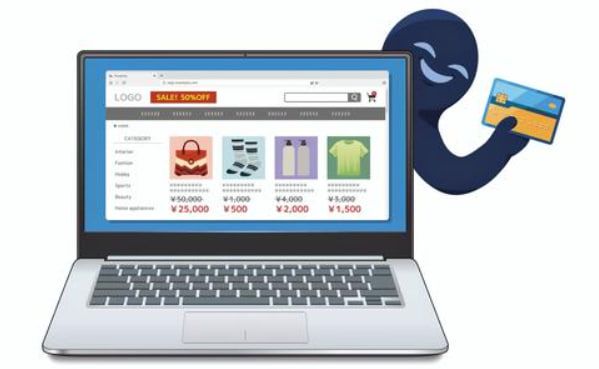
2. How to Identify Fake Shopping Websites
Fraudulent websites often share common traits that distinguish them from legitimate online stores. Belows are 9 of the most common key warning signs to help you learn how to spot a fake online store and protect yourself.
2.1. Check the URL
One of the quickest ways to recognize a fake website is when the domain name doesn’t match the official website of the company. Scammers often use domain names that closely resemble — or even include — the real URL within a misleading domain name.
Here are a few examples of how scammers can spoof domain names:
- BankoffAmerica.com (adding an extra “f”)
- Paypal.com.secure-site.com (in this case, the actual domain is “secure-site.com,” not “paypal.com”)
- WaImart.com (using a capital “i” instead of a lowercase “l”)
- Netflix-support.net (combining a spoofed domain with a different extension)
- Delivery.ips.com (adding “delivery” while spelling “UPS” as “IPS”)
Always double-check that you’re on the correct domain before entering any sensitive information. If you’re not absolutely sure you’re on a company’s official domain, you might be dealing with a fake site.
2.2. Look for a Padlock Symbol (But don’t rely on it much)
Most web browsers, such as Safari, Firefox, and Google Chrome, display a padlock symbol to indicate whether a website has a “security certificate” or SSL certificate, which encrypts information sent to the site.
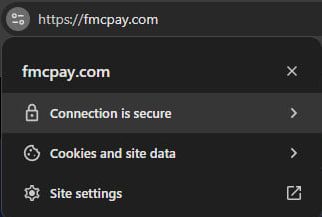
While the padlock can be a good sign, it doesn’t guarantee that you’re 100% safe, as scammers have begun using SSL certificates to deceive visitors into believing that their fake sites are genuine. If you’re uncertain, click on the padlock to check additional details about the security certificate.
Look for information such as the registered company name, country of origin, and other specific details. These signs indicate a higher level of security, known as an “Organization Validation (OV) certificate,” which scammers find harder to fake.
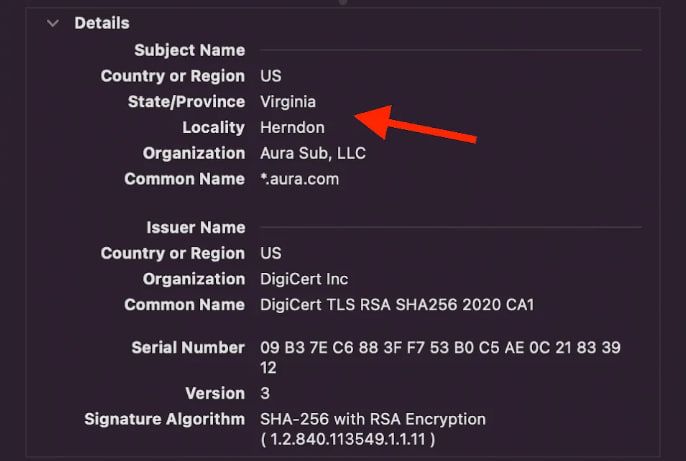
2.3. Use a Website Checker or Safe Browsing Tools
Website checkers can help you learn how to identify fake shopping websites by analyzing factors such as encryption use and verification certificates.
Here are some helpful resources for checking if a website is safe:
- Google Transparency Report: Examines billions of URLs daily to detect unsafe or compromised websites, warning users in browsers like Google Chrome.
- URLVoid: Scans URLs for harmful content and checks them against known scam databases.
Website checkers are a good starting point, but scammers have found ways to circumvent them. Therefore, it’s important to use multiple methods when figuring out how to identify fake shopping websites.
2.4. Check the Domain History
Another way to learn how to identify fake shopping websites is by checking the domain age. Fake sites usually don’t stay online for long. You can use the Whois Lookup domain tracker to see details such as the website’s owner, country of registration, and age of the domain. If a company claims to be registered in one country but the Whois information shows otherwise, it’s a red flag.
Alternatively, you can also use the Wayback Machine to view archived versions of the shopping site and verify if it has been used for different purposes over time.

2.5. Amateur Website Design
Scammers can now easily create e-commerce stores using online website builders or platforms like Shopify, which allow anyone to design a storefront in just a few steps.
The fake shopping website could be flagged as fraudulent and taken down. That’s why fraudsters prioritize speed and often opt for simple, low-cost templates that can be thrown together quickly. Watch for these design and content red flags that often signal you’re dealing with a phishing site:
- Poor Grammar & Typos: Legitimate companies have teams of writers who can catch language mistakes. Frequent errors are often a sign of a fake website.
- Pixelated or Low-Quality Images: Sometimes scammers may not have access to properly sized images or logos, so visuals on fake websites may appear blurry.
- Awkward Design and Layout: A site that’s difficult to navigate or missing sections can indicate that it’s fraudulent.
- No “About Us” Page: If this section is missing or seems fake, it’s likely a scam. Authentic companies typically provide some information about the brand or their physical address.
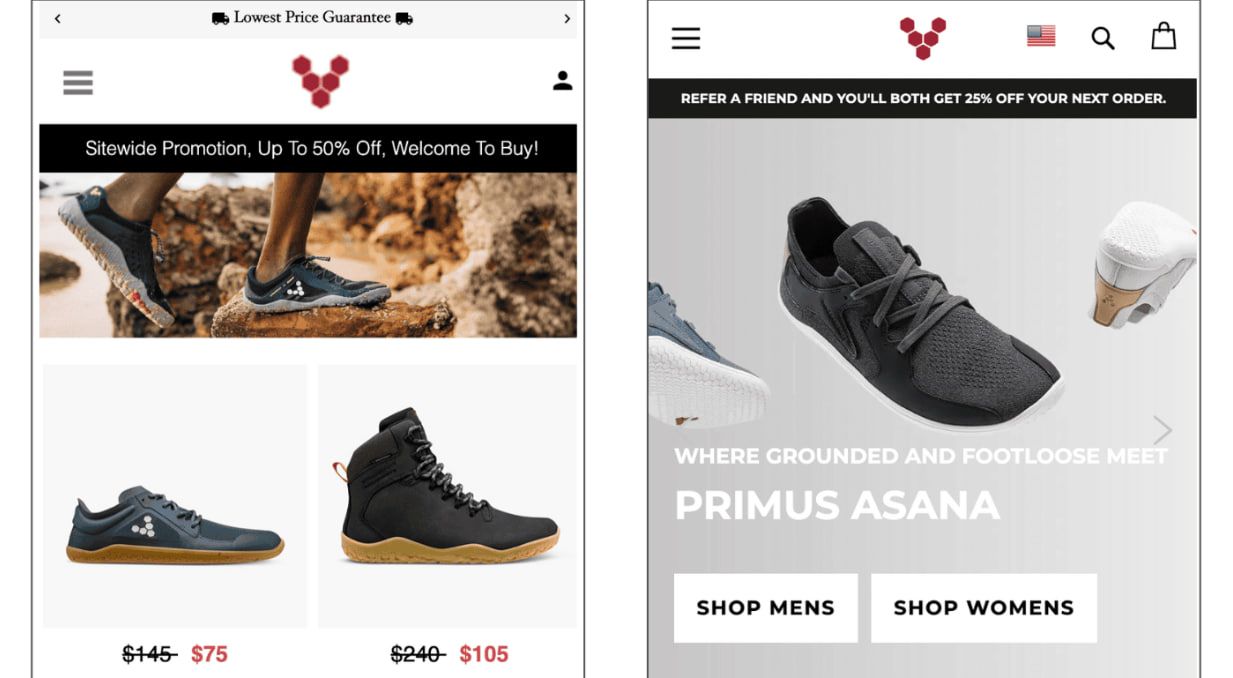
As shown in the image above, the suspected Vivobarefoot scam site (left) uses a pixelated logo compared to the real site (right). Product images on the fake site are low-resolution, indicating they’ve likely been copied. The campain banner on the left is also an outdated banner from the real website.
Next time you shop online, take time to explore the site thoroughly. Oversimplified, poorly designed pages are often a dead giveaway of a scam.
2.6. Limited Contact Details
When shopping online, always remember to confirm the seller’s physical address, support email, and phone number in case you have questions or concerns about your order.
Be cautious if the only way to communicate with the company is through a generic contact form. Ideally, the website should provide a physical address and a corporate email, not just a random Gmail account. If the contact details are limited or non-existent, raise your suspicions.
As shown in the picture below, the fake site (left) only offers a fill-in contact form as the contact method.
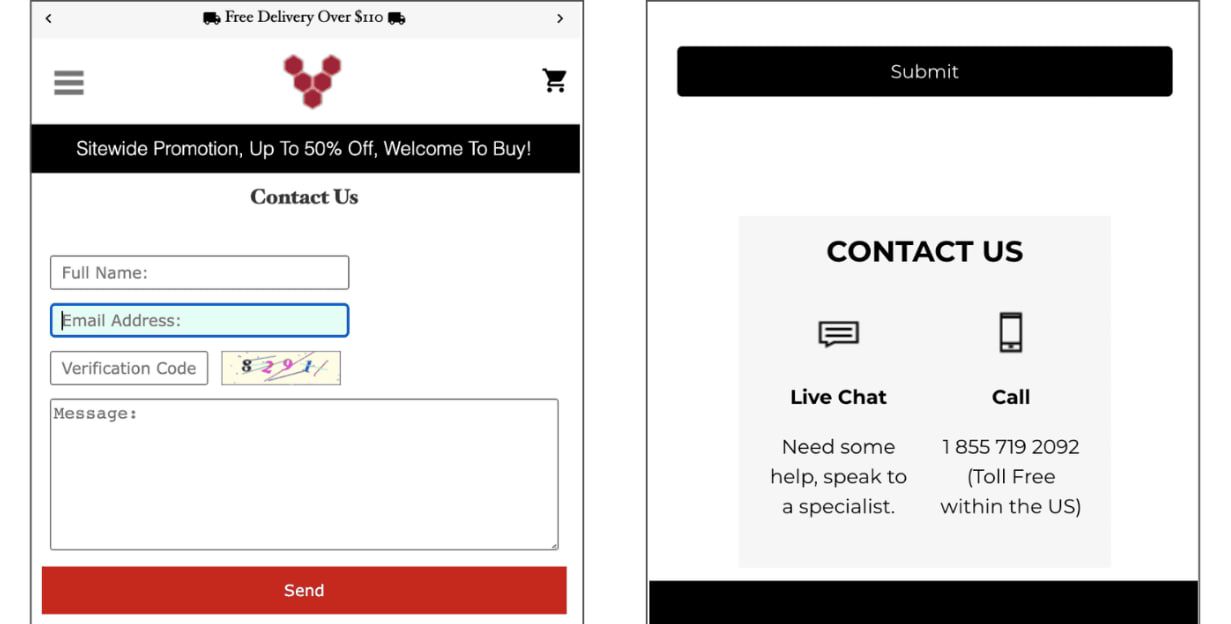
2.7. Complicated or Missing Return Policies
Reputable brands are transparent about their return and refund processes, ensuring they comply with consumer protection laws. In contrast, scammers often neglect this detail, with some fake shopping sites featuring confusing or non-existent return policies.
Authentic retail websites typically provide additional legal information such as a shipping policy, terms and conditions, privacy policy, and data collection practices. If this information is missing, it could be a warning sign. Recognizing this can help you learn how to identify fake shopping websites and avoid potential scams.
2.8. Suspicious Sections

Be wary of sections like “Customer Review” or “What Investors Say,” especially if they feature stock photos of people supposedly sharing their experiences. A quick Google search can often reveal that these images appear on multiple scam websites, indicating that the testimonials are fabricated and the supposed customers don’t actually exist.
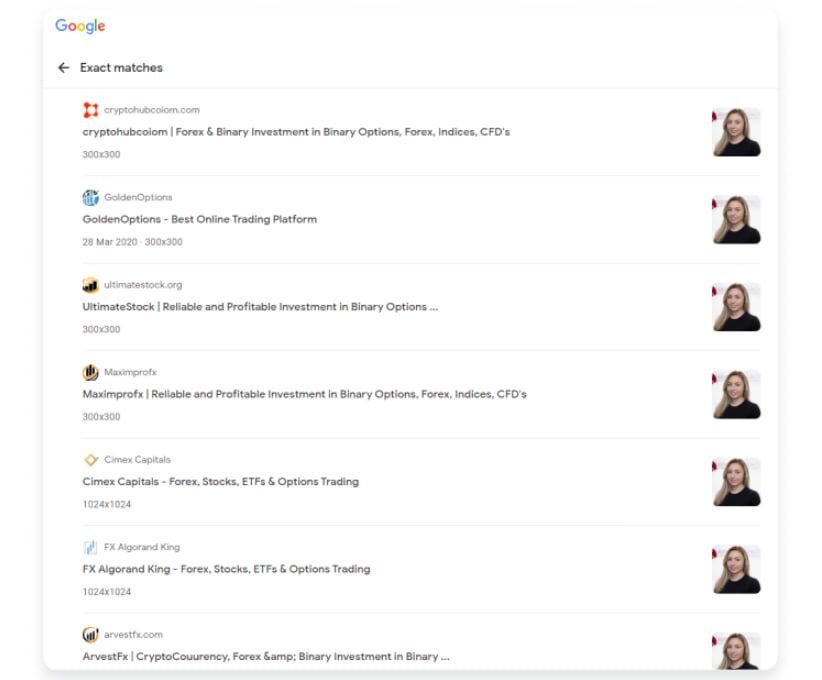
Some new brands that work hard may still use this method to build trust with customers, so don’t rely on this factor alone to decide whether a website is fake or not.
2.9. Questionable Payment Options
Legitimate brands typically allow customers to pay using traditional and secure methods, such as credit or debit cards, cash on delivery, or payment services Afterpay. In contrast, fake shopping websites often push for non-reversible payment methods, such as gift cards or cryptocurrencies, which are difficult to trace.
While credit and debit cards offer some protection against fraud, it’s a good practice to monitor your accounts for any unusual activity, especially during busy shopping seasons. If a site tries to limit your payment options to obscure methods, it could be a red flag indicating a scam.
For example, the fake Vivobarefoot website (left) asks users to make payments using a credit card or PayPal. This tactic is a common scam method that compels users to reveal their credit card information and may even redirect them to a counterfeit PayPal page, prompting them to input their personal payment details.
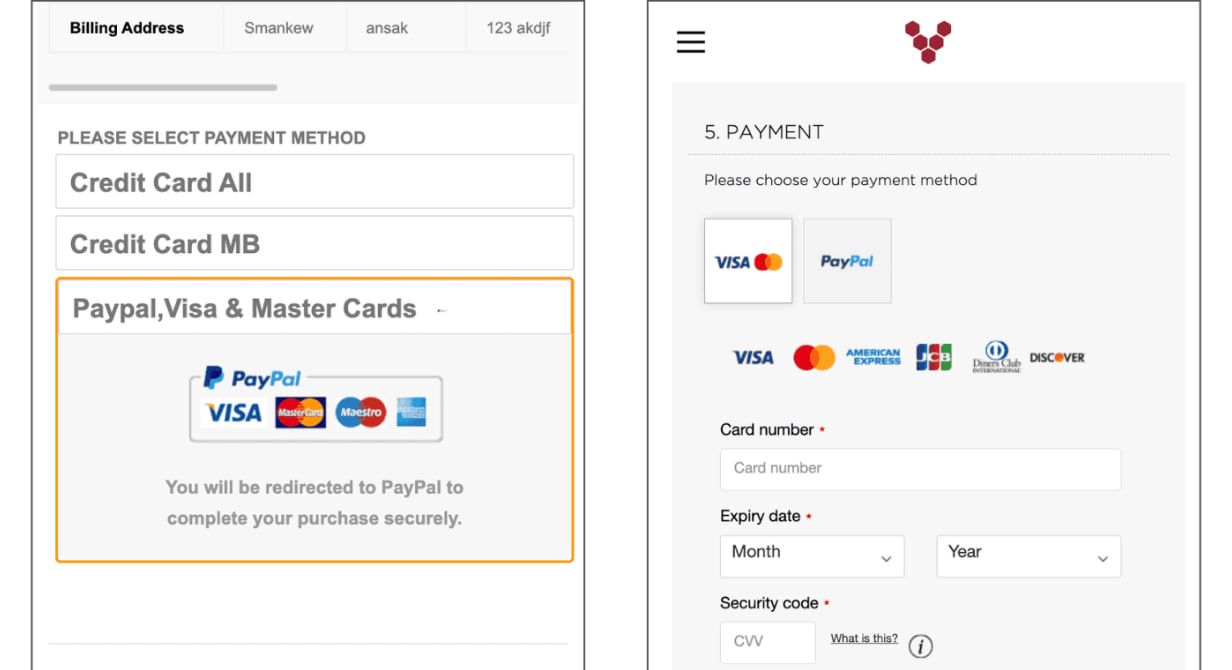
2.10. Bad social media
Another effective way to know how to identify fake shopping websites is by checking the site’s social media presence. Legitimate brands usually maintain active social media profiles across various platforms, using them to promote their products, share updates, and engage with their customers. These profiles not only enhance a brand’s credibility but also serve as a platform for customer feedback and interaction.
If you encounter a shopping site where the social media icons either lead to inactive pages or only prompt you to share the site’s URL, it’s a significant red flag. Additionally, you can search for the brand on social media to see if they have a following, respond to customer inquiries, and post regular content. A lack of genuine engagement or a minimal presence can indicate that the site is not legitimate.
3. What to Do if You Have Already Used a Fake Shopping Website
If you suspect that you have made a purchase on a fake shopping website, there are steps you can take to minimize the damage and protect yourself from further harm.
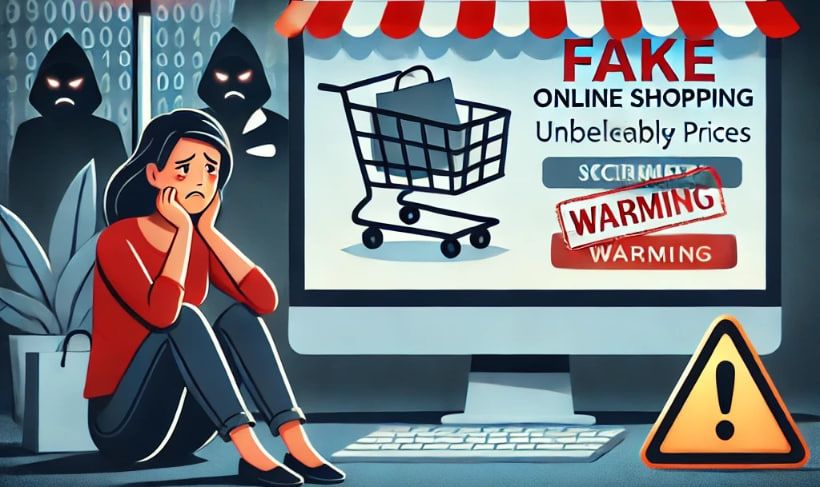
a) Contact Your Bank or Credit Card Company
The very first step is to immediately contact your bank or credit card company to report the incident. Explain that you suspect a fraudulent transaction and request to cancel the payment. Banks can often reverse charges for unauthorized transactions or put a hold on suspicious payments to prevent further losses.
b) Change Your Passwords
If you registered for an account on the fake shopping website, change your passwords immediately, especially if you used the same password for other accounts. Scammers often try to use the stolen information to access other accounts, so using different passwords for different services can help limit the damage.

c) Monitor Your Bank Statements
Keep an eye on your bank statements and credit card transactions for any unusual or unauthorized activity. If you notice additional charges you did not make, report them to your bank right away.
d) Report the Website
Reporting the fraudulent website to authorities can help protect others. You can report it to your country’s consumer protection agency, the platform where the site is hosted, or even a cybersecurity organization that tracks online scams.
e) Notify Others
Share your experience with friends, family, and online forums to warn others about the fake shopping website. Your warning could prevent someone else from falling victim to the same scam.
4. How To Report a Fake Shopping Website
Learning how to identify fake shopping websites is important to protect yourself, but taking action to report them can help take them down and prevent others from falling into the same trap. Here is how you can report these scam sites to the appropriate platforms and authorities.
4.1. Report the Scam Website to Google
You can report the fake website to Google by submitting its URL on the Google Safe Browsing page. Google has the ability to block access to fraudulent websites through its search engine and related products, such as YouTube.
Additionally, it can prevent Chrome and other browsers from loading the website and redirect emails containing links to the scam site directly to the spam folder in Gmail.

4.2. Report the Fake Website to Microsoft
You can also report the fake website to Microsoft by submitting its URL on the Microsoft Security Intelligence page. Just like Google, Microsoft can take action to restrict fraudulent websites. The company can block the website from appearing on Bing-based and Yahoo search engines, stop it from loading in Internet Explorer and Edge browsers, and prevent Outlook from receiving emails containing links to the reported scam site.
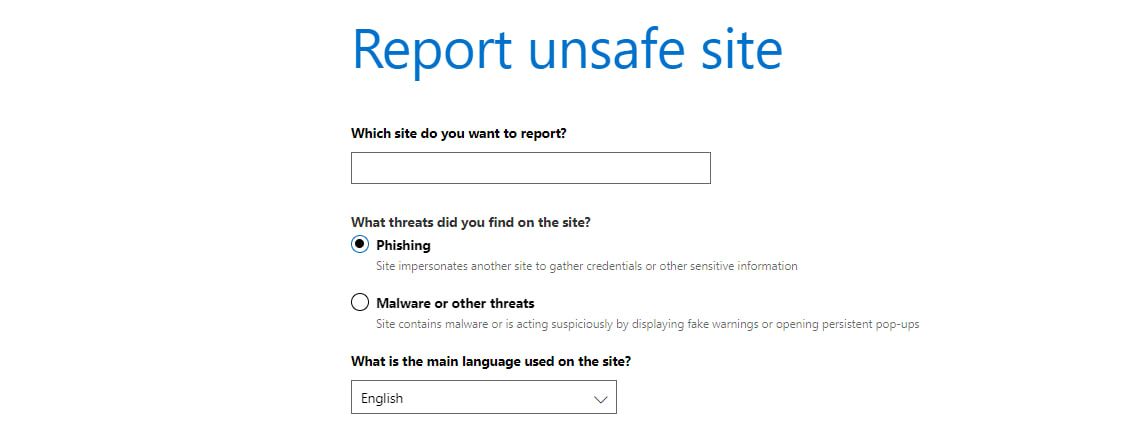
4.3. Report the Fraudulent Website to the Government
Government institutions have the authority to take down fake websites and may also assist in pursuing legal action against the perpetrators. You can report scam websites to various public authorities, such as:
- Filing a fraud report with the Federal Trade Commission (FTC) or by calling 1-877-382-4357.
- Reporting the incident to the Cybersecurity and Infrastructure Security Agency (CISA).
- Filing a complaint with the FBI’s Internet Crime Complaint Center (IC3).
Taking these steps not only helps with removing fake websites but also spreads awareness about how to identify fake shopping websites, making it easier for authorities to respond quickly to emerging threats.

4.4. Report the Fake Website to the Company It’s Impersonating
If the scam website is impersonating a legitimate company, notify the company directly through customer service or legal department. Many businesses have dedicated teams to handle such reports, and they can take legal action against the scammers.
For example, if a fraudulent website is mimicking a Amazon or PayPal, you can contact them via [email protected] or [email protected] accordingly and provide them with the fake shopping site’s URL. Companies often work with hosting providers and law enforcement to shut down these sites.
Conclusion
Learning how to identify fake shopping websites is a vital skill for anyone who shops online. By being aware of the warning signs that we’ve mentioned above, you can avoid being tricked by fraudulent sites.
If you’ve already encountered a fake website store, acting quickly can minimize the impact. Share this guide on how to identify fake shopping websites to help others avoid online scams, ensuring that everyone can enjoy the convenience of online shopping without falling victim.Stay tuned with FMCPAY for more helpful financial tips, trick & insights!

